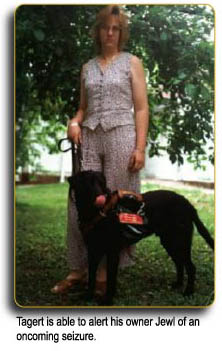


Christmas Store
The holidays are just around the corner so now is the time to fetch the finest gifts for the Labrador Lover on your Christmas list. We have over 100 gifts $50.00 and under. Visit our Christmas Store.
For the Lab
Bedding
Coats
Collars and Leads
Dog Bowls
Feeding Stations
Spa and Grooming
Toys and Treats
Travel and Accessories
For the Lab Lover
Apparel
Cards and Giftwrap
Fine Accessories
Gifts and All Occasions
Jewelry
Kids Only
For the Lab Home
Artwork
Books
Garden and Outdoor
Home Furnishings
Kitchen Accessories
Pillows, Throws, and Rugs
Gift ServicesGift Boxes
Gift Certificates
Extrasensory Pawception
By Ellen English
 Our beloved Labradors have an illustrious history as working dogs and have added to their resumes with careers as guide dogs for the blind, assistance dogs for the physically challenged and more recently, as hearing assistance dogs. Less known, but equally valuable, is the role that a Seizure Assistance Dog can play in the life of a person who suffers with epilepsy. This month, All Labs is very proud to feature Tagert, a 5 year old black Lab, who is one of the relatively rare dogs who can alert his owner of an impending seizure.
Our beloved Labradors have an illustrious history as working dogs and have added to their resumes with careers as guide dogs for the blind, assistance dogs for the physically challenged and more recently, as hearing assistance dogs. Less known, but equally valuable, is the role that a Seizure Assistance Dog can play in the life of a person who suffers with epilepsy. This month, All Labs is very proud to feature Tagert, a 5 year old black Lab, who is one of the relatively rare dogs who can alert his owner of an impending seizure.
Although millions of people suffer from seizure disorders and associated disabilities, the work of Seizure Assistance Dogs is still unfamiliar to and somewhat misunderstood by most of the general public. As Tagerts partner, Jewl Wall, explains: They serve those whose disability may be less obvious at times, but is dramatically debilitating when a seizure occurs. Most people with epilepsy or seizure disorders are afraid to go out of their homes, and the constant worry of their condition has inhibited their social life so they have few friends or anyone to assist them. Seizures are socially unacceptable, over whelming and embarrassing in our culture. This is especially devastating to young disabled children, particularly those in school. Dogs like Tagert make an immense difference in their lives. They provide comfort and security 24 hours a day and are the ideal friend to see right after coming out of a seizure-someone familiar and full of unconditional love. It is even believed that their reassuring presence may diminish the frequency of seizures. Tagert signals Jewl 10-20 minutes before an episode by nipping at her left hand. This gives her time to situate herself in a safe, comfortable spot and to prepare as best she can. Tagert may even herd her into this safe place and at times will actually lie on her lap to prevent her from walking around. Jewl, who has about 4 seizures a week, each lasting between 4 and 8 minutes, is able to maintain a great deal more independence because of Tagerts assistance.
It is believed that dogs like Tagert smell chemical changes in the body preceding a seizure and also pick up on other physical cues from their companions. Once a dog has lived with someone and formed a bond, they become very aware of their habits and movements. I wring my hands and rub my eyes before a seizure, Jewl explains. Seizure Alert Dogs then exhibit some natural behavior, often unique to the individual dog, to indicate to their companion that a seizure is on the way. Jewl knows of one dog whose alert or indication is to lick his companions face and another who carries all of her toys over and drops them in her owners lap! Other dogs will bark or whine in a particular way, or, like in Tagerts case, signal their partner with some physical contact. Regardless of their chosen form of communication, these dogs are exhibiting an extraordinary ability that cannot be trained, it is a super natural gift that they are compelled to share. As Jewl says, Divine intervention, in the form of an angel with paws instead of wings, came into my life.
It is possible to train Seizure Response Dogs who are able to summon help once a seizure has started. They use a paw to hit a certain button on specially equipped phones that will then dial a pre-programmed number for a chosen contact, such as the rescue squad or a spouse. The dog then barks into the receiver to let them know whos calling and why. Amazingly, as Jewl explains, the dogs can also be trained to clear the breathing area and remove fallen items that could cause harm during the clonic portion of a seizure [when extremities jerk and twitch.] The dogs can push [their companion] up by snuggling along the back to keep the person experiencing a seizure on their side. They can herd those who are afflicted with walk around seizures, and can lead one who is dazed after a seizure back home or to a safe area. As the group Epilepsy Ontario explains, After a seizure, the person may feel fatigue, confusion and disorientation. This may last from 5 minutes to several hours or even days. Rarely, this disorientation may last up to 2 weeks.

Tagerts career started at 6 weeks of age when a group called Sheppys Disability Dogs acquired him. Sheppys had been training dogs for several types of service work, but when their own pet dogs started reacting to their children's seizures, they saw the potential to help others with Epilepsy. Tagert passed the screening process which helps choose dogs that are gregarious and have a big sense of curiosity, Jewl explains. Dogs who tend to bond very strongly with people, who are especially scent-focused and eager to communicate with people, are the ones who make the best candidates. Tagert received over two hundred hours of training during the six to seven month period that Sheppys program entails. Their dogs are then able to perform twelve tasks and obey over 40 training commands.
Jewl woke up with cold-like symptoms in 1996 that turned into a 103.7 degree temperature and required her to be hospitalized. Her condition was eventually diagnosed as viral encephalitis, caused by the Epstein Barr virus, and has now turned into Epilepsy. Jewl found out about Sheppys unique program through a friend who is deaf. Rather than requiring an extended period of on-site training for the human candidate, (which can be quite a financial burden through lost work and hotel expenses) Sheppys videotaped Tagerts training in Tennessee and periodically sent these tapes on to Jewl in Indiana. To start the bonding process, Sheppys had Jewl send a t-shirt which shed slept in for at least 3 days that was then placed in Tagerts sleeping quarters. When she arrived to pick him up, they released him into the room where she (as well as her traveling companions and several others) were standing and he ran straight to me Jewl marvels as she recalls that magical day in 1998. When asked how Tagert got his name, she laughingly explains that she is fond of saying tag, youre it! on her friends answering machines and that line evolved into her dogs unusual name. Ironically, he also likes to play tag-he will touch his paws on your chest and run away, eager for the chase to begin!
Tagert is also fond of giving sugars (kisses) and pulling the stuffing out of his favorite toy, a Pooh bear that Jewl then lovingly re-sews (only to have Tagert begin the cycle again.) In answer to our question where does Tagert sleep? Jewl explains that upon moving into the home that she and her husband Michael now share, Tagert adopted the master bedroom closet as his own boudoir. As fun loving as Tagert is however, his work is never far from his mind. When shes having a bad night, Jewl says, he sleeps on the bed with me. Since seizures are by nature unpredictable, Tagert must perform his job whenever and wherever necessary, including such places as the Arlington Heights Race Track, where the family attends a yearly dog show event that is crowded with animals and thousands of people. Jewl also recalls an incident where Tagert nipped her husband on the hand for the first time and a particularly bad seizure followed. She cant say for sure whether there was a connection between the two events, but with the extraordinary nature of a dog like Tagert, it's probable.
Jewl perfectly sums up this Labs importance in her life and their special relationship: [he] gave me back mobility, independence, dignity and an appreciation for things in life that I used to take for granted. Thanks Tagert, youre the best. Even if you can't read this.
Tail End:
Established in 1985, Sheppy's is one of the first providers of Seizure Assistance Dogs. There are now over ten organizations that work to provide dogs to those with seizure disorders. To learn more about Sheppys Disability Dogs, as well as other groups, the Americans with Disabilities Act and Jewls efforts to educate the public, we invite you to visit these sites:
By Ellen English
 Our beloved Labradors have an illustrious history as working dogs and have added to their resumes with careers as guide dogs for the blind, assistance dogs for the physically challenged and more recently, as hearing assistance dogs. Less known, but equally valuable, is the role that a Seizure Assistance Dog can play in the life of a person who suffers with epilepsy. This month, All Labs is very proud to feature Tagert, a 5 year old black Lab, who is one of the relatively rare dogs who can alert his owner of an impending seizure.
Our beloved Labradors have an illustrious history as working dogs and have added to their resumes with careers as guide dogs for the blind, assistance dogs for the physically challenged and more recently, as hearing assistance dogs. Less known, but equally valuable, is the role that a Seizure Assistance Dog can play in the life of a person who suffers with epilepsy. This month, All Labs is very proud to feature Tagert, a 5 year old black Lab, who is one of the relatively rare dogs who can alert his owner of an impending seizure.Although millions of people suffer from seizure disorders and associated disabilities, the work of Seizure Assistance Dogs is still unfamiliar to and somewhat misunderstood by most of the general public. As Tagerts partner, Jewl Wall, explains: They serve those whose disability may be less obvious at times, but is dramatically debilitating when a seizure occurs. Most people with epilepsy or seizure disorders are afraid to go out of their homes, and the constant worry of their condition has inhibited their social life so they have few friends or anyone to assist them. Seizures are socially unacceptable, over whelming and embarrassing in our culture. This is especially devastating to young disabled children, particularly those in school. Dogs like Tagert make an immense difference in their lives. They provide comfort and security 24 hours a day and are the ideal friend to see right after coming out of a seizure-someone familiar and full of unconditional love. It is even believed that their reassuring presence may diminish the frequency of seizures. Tagert signals Jewl 10-20 minutes before an episode by nipping at her left hand. This gives her time to situate herself in a safe, comfortable spot and to prepare as best she can. Tagert may even herd her into this safe place and at times will actually lie on her lap to prevent her from walking around. Jewl, who has about 4 seizures a week, each lasting between 4 and 8 minutes, is able to maintain a great deal more independence because of Tagerts assistance.
It is believed that dogs like Tagert smell chemical changes in the body preceding a seizure and also pick up on other physical cues from their companions. Once a dog has lived with someone and formed a bond, they become very aware of their habits and movements. I wring my hands and rub my eyes before a seizure, Jewl explains. Seizure Alert Dogs then exhibit some natural behavior, often unique to the individual dog, to indicate to their companion that a seizure is on the way. Jewl knows of one dog whose alert or indication is to lick his companions face and another who carries all of her toys over and drops them in her owners lap! Other dogs will bark or whine in a particular way, or, like in Tagerts case, signal their partner with some physical contact. Regardless of their chosen form of communication, these dogs are exhibiting an extraordinary ability that cannot be trained, it is a super natural gift that they are compelled to share. As Jewl says, Divine intervention, in the form of an angel with paws instead of wings, came into my life.
It is possible to train Seizure Response Dogs who are able to summon help once a seizure has started. They use a paw to hit a certain button on specially equipped phones that will then dial a pre-programmed number for a chosen contact, such as the rescue squad or a spouse. The dog then barks into the receiver to let them know whos calling and why. Amazingly, as Jewl explains, the dogs can also be trained to clear the breathing area and remove fallen items that could cause harm during the clonic portion of a seizure [when extremities jerk and twitch.] The dogs can push [their companion] up by snuggling along the back to keep the person experiencing a seizure on their side. They can herd those who are afflicted with walk around seizures, and can lead one who is dazed after a seizure back home or to a safe area. As the group Epilepsy Ontario explains, After a seizure, the person may feel fatigue, confusion and disorientation. This may last from 5 minutes to several hours or even days. Rarely, this disorientation may last up to 2 weeks.

Tagerts career started at 6 weeks of age when a group called Sheppys Disability Dogs acquired him. Sheppys had been training dogs for several types of service work, but when their own pet dogs started reacting to their children's seizures, they saw the potential to help others with Epilepsy. Tagert passed the screening process which helps choose dogs that are gregarious and have a big sense of curiosity, Jewl explains. Dogs who tend to bond very strongly with people, who are especially scent-focused and eager to communicate with people, are the ones who make the best candidates. Tagert received over two hundred hours of training during the six to seven month period that Sheppys program entails. Their dogs are then able to perform twelve tasks and obey over 40 training commands.
Jewl woke up with cold-like symptoms in 1996 that turned into a 103.7 degree temperature and required her to be hospitalized. Her condition was eventually diagnosed as viral encephalitis, caused by the Epstein Barr virus, and has now turned into Epilepsy. Jewl found out about Sheppys unique program through a friend who is deaf. Rather than requiring an extended period of on-site training for the human candidate, (which can be quite a financial burden through lost work and hotel expenses) Sheppys videotaped Tagerts training in Tennessee and periodically sent these tapes on to Jewl in Indiana. To start the bonding process, Sheppys had Jewl send a t-shirt which shed slept in for at least 3 days that was then placed in Tagerts sleeping quarters. When she arrived to pick him up, they released him into the room where she (as well as her traveling companions and several others) were standing and he ran straight to me Jewl marvels as she recalls that magical day in 1998. When asked how Tagert got his name, she laughingly explains that she is fond of saying tag, youre it! on her friends answering machines and that line evolved into her dogs unusual name. Ironically, he also likes to play tag-he will touch his paws on your chest and run away, eager for the chase to begin!
Tagert is also fond of giving sugars (kisses) and pulling the stuffing out of his favorite toy, a Pooh bear that Jewl then lovingly re-sews (only to have Tagert begin the cycle again.) In answer to our question where does Tagert sleep? Jewl explains that upon moving into the home that she and her husband Michael now share, Tagert adopted the master bedroom closet as his own boudoir. As fun loving as Tagert is however, his work is never far from his mind. When shes having a bad night, Jewl says, he sleeps on the bed with me. Since seizures are by nature unpredictable, Tagert must perform his job whenever and wherever necessary, including such places as the Arlington Heights Race Track, where the family attends a yearly dog show event that is crowded with animals and thousands of people. Jewl also recalls an incident where Tagert nipped her husband on the hand for the first time and a particularly bad seizure followed. She cant say for sure whether there was a connection between the two events, but with the extraordinary nature of a dog like Tagert, it's probable.
Jewl perfectly sums up this Labs importance in her life and their special relationship: [he] gave me back mobility, independence, dignity and an appreciation for things in life that I used to take for granted. Thanks Tagert, youre the best. Even if you can't read this.
Tail End:
Established in 1985, Sheppy's is one of the first providers of Seizure Assistance Dogs. There are now over ten organizations that work to provide dogs to those with seizure disorders. To learn more about Sheppys Disability Dogs, as well as other groups, the Americans with Disabilities Act and Jewls efforts to educate the public, we invite you to visit these sites:
Sheppys Disability Dogs www.sheppys.com
Delta Society www.deltasociety.org
Americans with Disabilities Act-Service Dog Law Information Cards http://www.deltasociety.org/dsb010.htm
Jewl Walls site www.homestead.com/Tagert/MsJewl.html
Canine Partners for Life www.k94life.org
Types of Seizures/ Epilepsy Ontario http://epilepsyontario.org/faqs/seizures/../index.htm
Click here to go back to Lab of the Month
Featured Article
 Can You Spot The Holiday Hazards?
Can You Spot The Holiday Hazards?
It’s easy for pets, especially Labradors, to get into trouble during the holidays. You may get so busy that you lose track of what is going on with your dog.
Click here to learn more about: "Can You Spot The Holiday Hazards?"
 Can You Spot The Holiday Hazards?
Can You Spot The Holiday Hazards?It’s easy for pets, especially Labradors, to get into trouble during the holidays. You may get so busy that you lose track of what is going on with your dog.
Click here to learn more about: "Can You Spot The Holiday Hazards?"
Wanted: Models

Would you like to see your Lab pictured here? Send us images of your Lab and we may include them on our Home Page!

Would you like to see your Lab pictured here? Send us images of your Lab and we may include them on our Home Page!
Labrador Library
Labrador Links
The Verstaile Lab
History of the Lab
Advice
Travel
Featured Labs
Featured Artists
Labrador Links
The Verstaile Lab
History of the Lab
Advice
Travel
Featured Labs
Featured Artists
.jpg)

